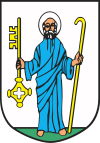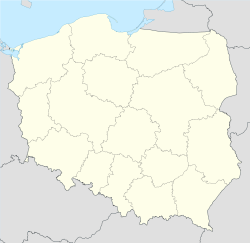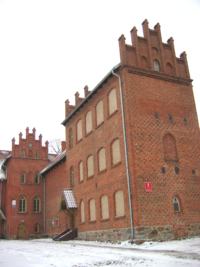- Olsztynek
-
Olsztynek 
Coat of armsCoordinates: 53°35′N 20°17′E / 53.583°N 20.283°E Country  Poland
PolandVoivodeship Warmian-Masurian County Olsztyn Gmina Olsztynek Area - Total 7.69 km2 (3 sq mi) Population (2006) - Total 7,591 - Density 987.1/km2 (2,556.6/sq mi) Postal code 11-015 Website http://www.olsztynek.pl Olsztynek [ɔlʂˈtɨnɛk] (German: Hohenstein) is a town in Poland, in Warmian-Masurian Voivodeship, in Olsztyn County. It has 7,648 inhabitants (2004).
Contents
History
The town was founded as Hohenstein by the Teutonic Order, which began to construct a castle in 1351 and granted Kulm law city rights in 1359.
The Battle of Grunwald in 1410 took place in the vicinity of the town.
It became a member of the Prussian Confederation in 1440, opposing the monastic state of the Teutonic Knights but returned to its rule in 1455. With the conversion of Albert of Prussia to Lutheranism in 1525, the town became part of Protestant Ducal Prussia, in 1618 part of Brandenburg-Prussia and after its creation part of the Kingdom of Prussia in 1701. After the unification of Germany the town lay inside the German Empire.
In the beginning of World War I in August 1914 the Russian Army occupied the region but has been defeated throughout the Battle of Tannenberg.
As a condition of the Treaty of Versailles the League of Nations held the East Prussian plebiscite on July 11, 1920 to determine if the people of the southern districts of East Prussia wanted to remain within East Prussia or to join the Second Polish Republic. Inside the town only 2 votes were given for Poland.
In remembrance of the battles a large Tannenberg Memorial was erected here in 1927, and made the place of the burial of the Weimar Republic's President Paul von Hindenburg in 1934. The memorial was partly demolished by the German forces withdrawing from the Soviet advance in 1945, after Hindenburg's coffin (and his wife's) were removed, and completely demolished by the Polish government in 1949. (A surviving lion is displayed in a Olsztynek square).
Until 1945 the town, known as Hohenstein in Ostpreußen, was part of Landkreis (district) Osterode in East Prussia. In January 1945 it was occupied by the Red Army throughout the East Prussian Offensive. Later it was handed over to Polish authorities, the German population was expelled and the region was resettled with Poles especially from Polish areas annexed by the Soviet Union.
In 1960 a memorial for the Battle of Grunwald was erected.
Famous Inhabitants
- Paul Kahle (1875-1964), orientalist
- Albert Lieven (1906–1971), actor
- Christoph Coelestin Mrongovius (1764–1855), Protestant Pastor, linguist
- Paul Wendland (1864–1915), classical philologist
Further reading
Aleksandr Solzhenitsyn describes the Battle of Tannenberg (1914) in his book "August 1914".
External links
Coordinates: 53°35′N 20°17′E / 53.583°N 20.283°E
Town and seat Olsztynek
Villages Ameryka · Cichogrąd · Czarci Jar · Czerwona Woda · Dąb · Dębowa Góra · Drwęck · Elgnówko · Gaj · Gąsiorowo Olsztyneckie · Gębiny · Gibała · Jadamowo · Jagiełek · Jemiołowo · Juńcza · Kąpity · Kolatek · Królikowo · Kunki · Kurki · Łęciny · Lichtajny · Lipowo Kurkowskie · Lutek · Łutynówko · Łutynowo · Makruty · Malinowo · Mańki · Marązy · Maróz · Marózek · Mierki · Mycyny · Nadrowo · Nowa Wieś Ostródzka · Orzechowo · Pawłowo · Platyny · Ruda Waplewska · Rybaczówka · Samagowo · Selwa · Sitno · Smolanek · Spogany · Stare Gaje · Sudwa · Świerkocin · Świętajńska Karczma · Świętajny · Tolejny · Tolkmity · Tomaszyn · Waplewo · Warglewo · Warlity Małe · Waszeta · Wigwałd · Wilkowo · Witramowo · Witułty · Ząbie · Zawady · Zezuty
Categories:- Cities and towns in Warmian-Masurian Voivodeship
- Olsztyn County
Wikimedia Foundation. 2010.


